JEE (Advanced)-2019 PAPER-2
PART-I : PHYSICS
SECTION – 1 (Maximum Marks : 32)
• This section contains EIGHT (08) questions.
• Each question has FOUR options. ONE OR MORE THAN ONE of these four option(s) is(are) correct answer(s).
• For each question, choose the option(s) corresponding to (all) the correct answer(s).
• Answer to each question will be evaluated according to the following marking scheme:
Full Marks : +4 If only (all) the correct option(s) is(are) chosen;
Partial Marks : +3 If all the four options are correct but ONLY three options are chosen;
Partial Marks : +2 If three or more options are correct but ONLY two options are chosen, and both of which are correct;
Partial Marks : +1 If two or more options are correct but ONLY one option is chosen and it is a correct option;
Zero Marks : 0 If none of the options is chosen (i.e. the question is unanswered);
Negative Marks : –1 In all other cases.
• For example : in a question, if (A), (B) and (D) are the ONLY three options corresponding to correct answers, then
choosing ONLY (A), (B) and (D) will get +4 marks;
choosing ONLY (A) and (B) will get +2 marks;
choosing ONLY (A) and (D) will get +2 marks;
choosing ONLY (B) and (D) will get +2 marks;
choosing ONLY (A) will get +1 mark;
choosing ONLY (B) will get +1 mark;
choosing ONLY (D) will get +1 mark;
choosing no option (i.e., the question is unanswered) will get 0 marks; and
choosing any other combination of options will get –1 mark.
1. A thin and uniform rod of mass M and length L is held vertical on a floor with large friction. The rod is released from rest so that it falls by rotating about its contact-point with the floor without slipping. Which of the following statement(s) is/are correct, when the rod makes an angle 60° with vertical ?
[g is the acceleration due to gravity]
(A) The angular speed of the rod will be ![]()
(B) The angular acceleration of the rod will be 2g/L
(C) The radial acceleration of the rod’s center of mass will be 3g/4
(D) The normal reaction force from the floor on the rod will be Mg/16
2. A block of mass 2M is attached to a massless spring with spring-constant k. This block is connected to two other blocks of masses M and 2M using two massless pulleys and strings. The accelerations of the blocks are a1 , a2 and a3 as shown in the figure. The system is released from rest with the spring in its unstretched state. The maximum extension of the spring is x0 . Which of the following option(s) is/are correct?
[g is the acceleration due to gravity. Neglect friction]

(A) ![]()
(B) When spring achieves an extension of x0/2 for the first time, the speed of the block connected to the spring is ![]()
(C) At an extension of x0/4 of the spring, the magnitude of acceleration of the block connected to the spring is 3g/10
(D) a2 – a1 = a1 – a3
3. A small particle of mass m moving inside a heavy, hollow and straight tube along the tube axis undergoes elastic collision at two ends. The tube has no friction and it is closed at one end by a flat surface while the other end is fitted with a heavy movable flat piston as shown in figure. When the distance of the piston from closed end is L = L0 the particle speed is v = v 0 . The piston is moved inward at a very low speed V such that ![]() where dL is the infinitesimal displacement of the piston. Which of the following statement(s) is/are correct?
where dL is the infinitesimal displacement of the piston. Which of the following statement(s) is/are correct?

(A) The rate at which the particle strikes the piston v/L
(B) After each collision with the piston, the particle speed increases by 2V
(C) If the piston moves inward by dL, the particle speed increases by ![]()
(D) The particle’s kinetic energy increases by a factor of 4 when the piston is moved inward from L0 to![]()
4. An electric dipole with dipole moment ![]() is held fixed at the origin O in the presence of an uniform electric field of magnitude E0. If the potential is constant on a circle of radius R centered at the origin as shown in figure, then the correct statement(s) is/are:
is held fixed at the origin O in the presence of an uniform electric field of magnitude E0. If the potential is constant on a circle of radius R centered at the origin as shown in figure, then the correct statement(s) is/are:
(ε0 is permittivity of free space. R >> dipole size)

(A) 
(B) Total electric field at point A is ![]()
(C) Total electric field at point B is ![]()
(D) The magnitude of total electric field on any two points of the circle will be same.
5. A mixture of ideal gas containing 5 moles of monatomic gas and 1 mole of rigid diatomic gas is initially at pressure P0 , volume V0 , and temperature T0 . If the gas mixture is adiabatically compressed to a volume V0 /4, then the correct statement(s) is/are, (Given 22 = 2.3; 23.2 = 9.2; R is gas constant)
(A) The work |W| done during the process is 13RT0
(B) The average kinetic energy of the gas mixture after compression is in between 18RT0 and 19RT0
(C) The final pressure of the gas mixture after compression is in between 9P0 and 10P0
(D) Adiabatic constant of the gas mixture is 1.6
6. Three glass cylinders of equal height H = 30 cm and same refractive index n = 1.5 are placed on a horizontal surface as shown in figure. Cylinder I has a flat top, cylinder II has a convex top and cylinder III has a concave top. The radii of curvature of the two curved tops are same (R = 3 m). If H1 , H2 , and H3 are the apparent depths of a point X on the bottom of the three cylinders, respectively, the correct statement(s) is/are:

(A) H2 > H1
(B) H3 > H1
(C) H2 > H3
(D) 0.8 cm < (H2 – H1) < 0.9 cm
7. In a Young’s double slit experiment, the slit separation d is 0.3 mm and the screen distance D is 1 m. A parallel beam of light of wavelength 600 nm is incident on the slits at angle α as shown in figure. On the screen, the point O is equidistant from the slits and distance PO is 11.0 mm. Which of the following statement(s) is/are correct?

(A) For ![]() there will be destructive interference at point O.
there will be destructive interference at point O.
(B) For α = 0, there will be constructive interference at point P.
(C) For ![]() there will be destructive interference at point P.
there will be destructive interference at point P.
(D) Fringe spacing depends on α.
8. A free hydrogen atom after absorbing a photon of wavelength λa gets excited from the state n = 1 to the state n = 4. Immediately after that the electron jumps to n = m state by emitting a photon of wavelength λe. Let the change in momentum of atom due to the absorption and the emission are ∆pa and ∆pe, respectively. If λa/λe = 1/5, which of the option(s) is/are correct?
[Use hc = 1242 eV nm; 1 nm = 10−9 m, h and c are Planck’s constant and speed of light, respectively)
(A) m = 2
(B) λe = 418 nm
(C) ∆pa/∆pe = 1/2
(D) The ratio of kinetic energy of the electron in the state n = m to the state n = 1 is 1/4
SECTION – 2 (Maximum Marks : 18)
• This section contains SIX (06) questions. The answer to each question is a NUMERICAL VALUE.
• For each question, enter the correct numerical value of the answer using the mouse and the on-screen virtual numeric keypad in the place designated to enter the answer. If the numerical value has more than two decimal places, truncate/round-off the value to TWO decimal places.
• Answer to each question will be evaluated according to the following marking scheme:
Full Marks : +3 If ONLY the correct numerical value is entered.
Zero Marks : 0 In all other cases.
9. A ball is thrown from ground at an angle θ with horizontal and with an initial speed u0. For the resulting projectile motion, the magnitude of average velocity of the ball up to the point when it hits the ground for the first time is V1 . After hitting the ground, the ball rebounds at the same angle θ but with a reduced speed of u0/α. Its motion continues for a long time as shown in figure. If the magnitude of average velocity of the ball for entire duration of motion is 0.8 V1, the value of α is _________.

10. A 10 cm long perfectly conducting wire PQ is moving with a velocity 1 cm/s on a pair of horizontal rails of zero resistance. One side of the rails is connected to an inductor L = 1 mH and a resistance R = 1 Ω as shown in figure. The horizontal rails, L and R lie in the same plane with a uniform magnetic field B = 1 T perpendicular to the plane. If the key S is closed at certain instant, the current in the circuit after 1 millisecond is x × 10–3 A, where the value of x is ______.

[Assume the velocity of wire PQ remains constant (1 cm/s) after key S is closed. Given: e–1 = 0.37, where e is base of the natural logarithm]
11. A monochromatic light is incident from air on a refracting surface of a prism of angle 75° and refractive index n0 = √ The other refracting surface of the prism is coated by a thin film of material of refractive index n as shown in figure. The light suffers total internal reflection at the coated prism surface for an incidence angle of θ ≤ 60°. The value of n2 is _______.

12. A perfectly reflecting mirror of mass M mounted on a spring constitutes a spring-mass system of angular frequency Ω such that ![]() with h as Planck’s constant, N photons of wavelength λ = 8π × 10–6 m strike the mirror simultaneously at normal incidence such that the mirror gets displaced by 1 μ If the value of N is x × 1012, then the value of x is _______.
with h as Planck’s constant, N photons of wavelength λ = 8π × 10–6 m strike the mirror simultaneously at normal incidence such that the mirror gets displaced by 1 μ If the value of N is x × 1012, then the value of x is _______.
[Consider the spring as massless]

13. Suppose a ![]() nucleus at rest and in ground state undergoes α-decay to a
nucleus at rest and in ground state undergoes α-decay to a ![]() nucleus in its excited state. The kinetic energy of the emitted α particle is found to be 4.44 MeV.
nucleus in its excited state. The kinetic energy of the emitted α particle is found to be 4.44 MeV. ![]() nucleus then goes to its ground state by γ-decay. The energy of the emitted γ photon is _______ keV.
nucleus then goes to its ground state by γ-decay. The energy of the emitted γ photon is _______ keV.
[Given: atomic mass of ![]() atomic mass of
atomic mass of ![]() atomic mass of α particle = 4.00 u, 1 u = 931 MeV/c2, c is speed of the light]
atomic mass of α particle = 4.00 u, 1 u = 931 MeV/c2, c is speed of the light]
14. An optical bench has 1.5 m long scale having four equal divisions in each cm. While measuring the focal length of a convex lens, the lens is kept at 75 cm mark of the scale and the object pin is kept at 45 cm mark. The image of the object pin on the other side of the lens overlaps with image pin that is kept at 135 cm mark. In this experiment, the percentage error in the measurement of the focal length of the lens is _______.
SECTION – 3 (Maximum Marks : 12)
• This section contains TWO (02) List-Match sets.
• Each List-Match set has TWO (02) Multiple Choice Questions.
• Each List-Match set has two lists: List-I and List-II.
• List-I has Four entries (I), (II), (III) and (IV) and List-II has Six entries (P), (Q), (R), (S), (T) and (U).
• Four options are given in each Multiple Choice Question based on List-I and List-II and ONLY ONE of these four options satisfies the condition asked in the Multiple Choice Question.
• Answer to each question will be evaluated according to the following marking scheme:
Full Marks : +3 If ONLY the option corresponding to the correct combination is chosen;
Zero Marks : 0 If none of the options is chosen (i.e. the question is unanswered);
Negative Marks : –1 In all other cases.
Answer Q. 15 and Q. 16 by appropriately matching the lists based on the information given in the paragraph
A musical instrument is made using four different metal strings. 1, 2, 3 and 4 with mass per unit length μ, 2μ, and 4μ respectively. The instrument is played by vibrating the strings by varying the free length in between the range L0 and 2L0. It is found that in string-1 (μ) at free length L0 and tension T0 the fundamental mode frequency is f0
.List-I gives the above four strings while list-II lists the magnitude of some quantity.

15. If the tension in each string is T0, the correct match for the highest fundamental frequency in f0 units will be.
(A) I → P, II → Q, III → T, IV → S
(B) I → P, II → R, III → S, IV → Q
(C) I → Q, II → S, III → R, IV → P
(D) I → Q, II → P, III → R, IV → T
16. The length of the strings 1, 2, 3 and 4 are kept fixed at L0, 3L0/2, 5L0/4, and 7L0/4, respectively. Strings 1, 2, 3 and 4 are vibrated at their 1st, 3rd, 5th, and 14th harmonics, respectively such that all the strings have same frequency. The correct match for the tension in the four strings in the units of T0 will be,
(A) I → P, II → R, III → T, IV → U
(B) I → P, II → Q, III → T, IV → U
(C) I → P, II → Q, III → R, IV → T
(D) I → T, II → Q, III → R, IV → U
Answer Q. 17 and Q. 18 by appropriately matching the lists based on the information given in the paragraph
Answer the following by appropriately matching the lists based on the information given in the paragraph In a thermodynamic process on an ideal monatomic gas, the infinitesimal heat absorbed by the gas is given by T∆X, where T is temperature of the system and ∆X is the infinitesimal change in a thermodynamic quantity X of the system. For a mole of monatomic ideal gas ![]() Here, R is gas constant, V is volume of gas, TA and VA are constants.
Here, R is gas constant, V is volume of gas, TA and VA are constants.
The List-I below gives some quantities involved in a process and List-II gives some possible values of these quantities.
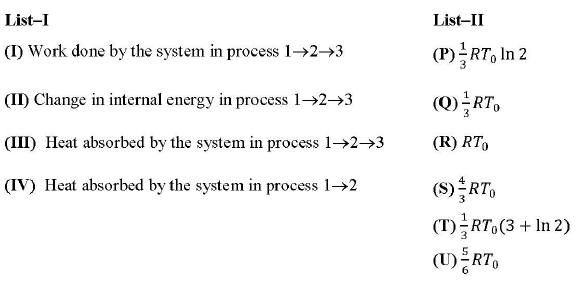
17. If the process carried out on one mole of monatomic ideal gas is as shown in figure in the PV-diagram with ![]() the correct match is,
the correct match is,

(A) I → Q, II → R, III → P, IV → U
(B) I → Q, II → R, III → S, IV → U
(C) I → S, II → R, III → Q, IV → T
(D) I → Q, II → S, III → R, IV → U
18. If the process on one mole of monatomic ideal gas is as shown in the TV-diagram with the correct match is,
(A) I → P, II → R, III → T, IV → S
(B) I → P, II → T, III → Q, IV → T
(C) I → P, II → R, III → T, IV → P
(D) I → S, II → T, III → Q, IV → U
JEE (ADVANCED) 2019 PAPER 2
PART-II CHEMISTRY
SECTION – 1 (Maximum Marks : 32)
• This section contains EIGHT (08) questions.
• Each question has FOUR options. ONE OR MORE THAN ONE of these four option(s) is(are) correct answer(s).
• For each question, choose the option(s) corresponding to (all) the correct answer(s).
• Answer to each question will be evaluated according to the following marking scheme:
Full Marks : +4 If only (all) the correct option(s) is(are) chosen;
Partial Marks : +3 If all the four options are correct but ONLY three options are chosen;
Partial Marks : +2 If three or more options are correct but ONLY two options are chosen, and both of which are correct;
Partial Marks : +1 If two or more options are correct but ONLY one option is chosen and it is a correct option;
Zero Marks : 0 If none of the options is chosen (i.e. the question is unanswered);
Negative Marks : –1 In all other cases.
• For example : in a question, if (A), (B) and (D) are the ONLY three options corresponding to correct answers, then
choosing ONLY (A), (B) and (D) will get +4 marks;
choosing ONLY (A) and (B) will get +2 marks;
choosing ONLY (A) and (D) will get +2 marks;
choosing ONLY (B) and (D) will get +2 marks;
choosing ONLY (A) will get +1 mark;
choosing ONLY (B) will get +1 mark;
choosing ONLY (D) will get +1 mark;
choosing no option (i.e., the question is unanswered) will get 0 marks; and
choosing any other combination of options will get –1 mark.
1. The cyanide process of gold extraction involves leaching out gold from its ore with CN– in the presence of Q in water to form R. Subsequently, R is treated with T to obtain Au and Z. Choose the correct option(s)
(A) Q is O2
(B) T is Zn
(C) Z is [Zn(CN)4]2−
(D) R is [Au(CN)4]−
2. With reference to aqua regia, choose the correct option(s).
(A) Aqua regia is prepared by mixing conc. HCl and conc. HNO3 in 3 : 1 (v/v) ratio
(B) Reaction of gold with aqua regia produces an anion having Au in +3 oxidation state
(C) Reaction of gold with aqua regia produces NO2 in the absence of air
(D) The yellow colour of aqua regia is due to the presence of NOCl and Cl2
3. Consider the following reactions (unbalanced)
Zn + hot conc. H2SO4 → G + R + X
Zn + conc. NaOH → T + Q
G + H2S + NH4OH →Z (a precipitate) + X + Y
Choose the correct option(s)
(A) Z is dirty white in colour
(B) The oxidation state of Zn in T is +1
(C) R is a V-shaped molecule
(D) Bond order of Q is in its ground state
4. The ground state energy of hydrogen atom is –13.6 eV. Consider an electronic state Ψ of He+ whose energy, azimuthal quantum number and magnetic quantum number are –3.4 eV, 2 and 0, respectively. Which of the following statement(s) is(are) true for the state Ψ?
(A) It is a 4d state
(B) It has 2 angular nodes
(C) It has 3 radial nodes
(D) The nuclear charge experienced by the electron in this state is less than 2e, where e is the magnitude of the electronic charge
5. Which of the following reactions produce(s) propane as a major product?

6. Choose the correct option(s) that give(s) an aromatic compound as the major product

7. Choose the correct option(s) for the following reaction sequence

Consider Q, R and S as major products
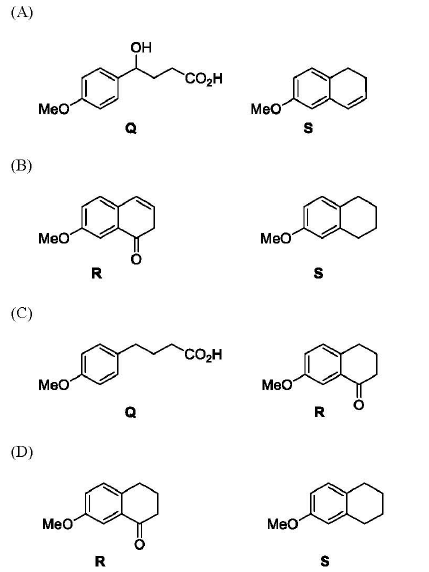
8. Choose the correct option(s) from the following
(A) Natural rubber is polyisoprene containing trans alkene units
(B) Nylon-6 has amide linkages
(C) Teflon is prepared by heating tetrafluoroethene is presence of a persulphate catalyst pressure
(D) Cellulose has only α-D-glucose units that are joined by glycosidic linkages
SECTION – 2 (Maximum Marks : 18)
• This section contains SIX (06) questions. The answer to each question is a NUMERICAL VALUE.
• For each question, enter the correct numerical value of the answer using the mouse and the on-screen virtual numeric keypad in the place designated to enter the answer. If the numerical value has more than two decimal places, truncate/round-off the value to TWO decimal places.
• Answer to each question will be evaluated according to the following marking scheme:
Full Marks : +3 If ONLY the correct numerical value is entered.
Zero Marks : 0 In all other cases.
9. The amount of water produced (in g) in the oxidation of 1 mole of rhombic sulphur by conc. HNO3 to a compound with the highest oxidation state of sulphur is ___
10. Total number of cis N–Mn–Cl bond angles (that is, Mn–N and Mn–Cl bonds in cis positions) present in a molecule of cis-[Mn(en)2Cl2] complex is _________
(en = NH2CH2CH2NH2)
11. The decomposition reaction ![]() is started in a closed cylinder under isothermal isochoric condition at an initial pressure of 1 atm. After Y × 103 s, the pressure inside the cylinder is found to be 1.45 atm. If the rate constant of the reaction is 5 × 10–4 s–1, assuming ideal gas behavior, the value of Y is __________.
is started in a closed cylinder under isothermal isochoric condition at an initial pressure of 1 atm. After Y × 103 s, the pressure inside the cylinder is found to be 1.45 atm. If the rate constant of the reaction is 5 × 10–4 s–1, assuming ideal gas behavior, the value of Y is __________.
12. The mole fraction of urea in an aqueous urea solution containing 900 g of water is 0.05. If the density of the solution is 1.2 g cm–3, the molarity of urea solution is ________
(Given data: molar masses of urea and water are 60 g mol−1 and 18 g mol−1, respectively)
13. Total number of hydroxyl groups present in a molecule of the major product P is ____

14. Total number of isomers, considering both structural and stereoisomers, of cyclic ethers with the molecular formula C4H8O is ____
SECTION – 3 (Maximum Marks : 12)
• This section contains TWO (02) List-Match sets.
• Each List-Match set has TWO (02) Multiple Choice Questions.
• Each List-Match set has two lists: List-I and List-II.
• List-I has Four entries (I), (II), (III) and (IV) and List-II has Six entries (P), (Q), (R), (S), (T) and (U).
• Four options are given in each Multiple Choice Question based on List-I and List-II and ONLY ONE of these four options satisfies the condition asked in the Multiple Choice Question.
• Answer to each question will be evaluated according to the following marking scheme:
Full Marks : +3 If ONLY the option corresponding to the correct combination is chosen;
Zero Marks : 0 If none of the options is chosen (i.e. the question is unanswered);
Negative Marks : –1 In all other cases.
Answer Q. 15 and Q. 16 by appropriately matching the lists based on the information given in the paragraph
Consider the Bohr’s model of a one-electron atom where the electron moves around the nucleus. In the following, List-I contains some quantities for the nth orbit of the atom and List-II contains options showing how they depend on n.
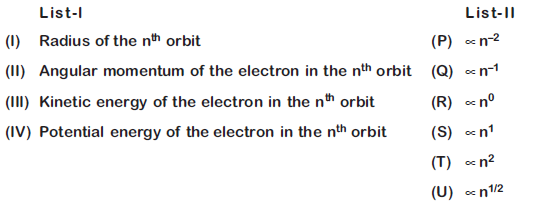
15. Which of the following options has the correct combination considering List-I and List-II?
(A) (I), (P)
(B) (I), (T)
(C) (II), (Q)
(D) (II), (R)
16. Which of the following options has the correct combination considering List-I and List-II?
(A) (III), (P)
(B) (III), (S)
(C) (IV), (Q)
(D) (IV), (U)
Answer Q. 17 and Q. 18 by appropriately matching the lists based on the information given in the paragraph
List-I includes starting materials and reagents of selected chemical reactions List-II gives structures of compounds that may be formed as intermediate products and/or final products from the reactions of List-I.
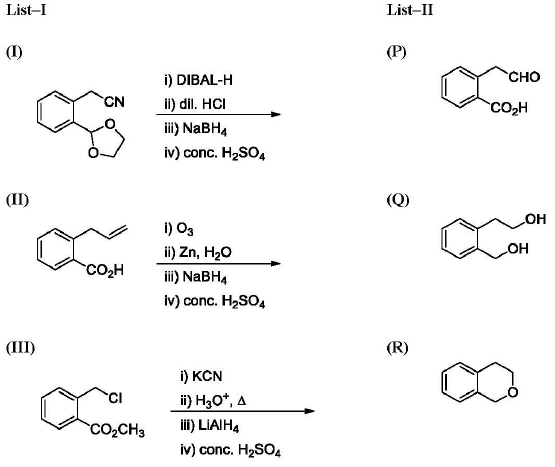
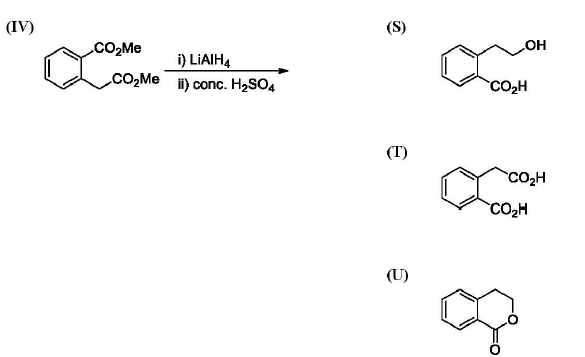
17. Which of the following options has correct combination considering List-I and List-II?
(A) (I), (Q), (T), (U)
(B) (II), (P), (S), (T)
(C) (II), (P), (S), (U)
(D) (I), (S), (Q), (R)
18. Which of the following options has correct combination considering List-I and List-II?
(A) (III), (S), (R)
(B) (IV), (Q), (U)
(C) (III), (T), (U)
(D) (IV), (Q), (R)
JEE (ADVANCED) 2019 PAPER 2
PART-III MATHEMATICS
SECTION – 1 (Maximum Marks : 32)
• This section contains EIGHT (08) questions.
• Each question has FOUR options. ONE OR MORE THAN ONE of these four option(s) is(are) correct answer(s).
• For each question, choose the option(s) corresponding to (all) the correct answer(s).
• Answer to each question will be evaluated according to the following marking scheme:
Full Marks : +4 If only (all) the correct option(s) is(are) chosen;
Partial Marks : +3 If all the four options are correct but ONLY three options are chosen;
Partial Marks : +2 If three or more options are correct but ONLY two options are chosen, and both of which are correct;
Partial Marks : +1 If two or more options are correct but ONLY one option is chosen and it is a correct option;
Zero Marks : 0 If none of the options is chosen (i.e. the question is unanswered);
Negative Marks : –1 In all other cases.
• For example : in a question, if (A), (B) and (D) are the ONLY three options corresponding to correct answers, then
choosing ONLY (A), (B) and (D) will get +4 marks;
choosing ONLY (A) and (B) will get +2 marks;
choosing ONLY (A) and (D) will get +2 marks;
choosing ONLY (B) and (D) will get +2 marks;
choosing ONLY (A) will get +1 mark;
choosing ONLY (B) will get +1 mark;
choosing ONLY (D) will get +1 mark;
choosing no option (i.e., the question is unanswered) will get 0 marks; and
choosing any other combination of options will get –1 mark.
1. Let



where PkT denotes the transpose of the matrix Pk. Then which of the following options is/are correct?
(A) 
(B) X is a symmetric matrix
(C) The sum of diagonal entries of X is 18
(D) X – 30I is an inverible matrix
2. Let x ∈ ℝ and let
 and R = PQP−1.
and R = PQP−1.
Then which of the following options is/are correct?
(A) There exists a real number x such that PQ = QP
(B) 
(C) 
(D) For x = 1, there exists a unit vector 
3. For non-negative integers n, let

Assuming cos−1 x takes values in [0, π], which of the following options is/are correct?
(A) f(4) = √3/2
(B) ![]()
(C) If α = tan(cos−1 f(6)), then α2 + 2α – 1 = 0
(D) sin(7 cos−1f(5)) = 0
4. Let f : ℝ → ℝ be a function. We say that f has
PROPERTY 1 if ![]() exists and is finite, and
exists and is finite, and
PROPERTY 2 if ![]() exists and is finite.
exists and is finite.
Then which of the following options is/are correct?
(A) f(x) = |x| has PROPERTY 1
(B) f(x) = x2/3 has PROPERTY 1
(C) f(x) = x|x| has PROPERTY 2
(D) f(x) = sin x has PROPERTY 2
5. Let

Let x1 < x2 < x3 < … < xn < … be all the points of local maximum of f
and y1 < y2 < y3 < … < yn < … be all the points of local minimum of f.
Then which of the following options is/are correct?
(A) x1 < y1
(B) xn+1 – xn > 2 for every n
(C) ![]()
(D) |xn – yn| > 1 for every n
6. For a ∈ ℝ, |a| > 1, let

Then the possible value(s) of a is/are
(A) −9
(B) −6
(C) 7
(D) 8
7. Let f : ℝ → ℝ be given by f(x) = (x – 1) (x – 2) (x – 5). Define

Then which of the following options is/are correct?
(A) F has a local minimum at x= 1
(B) F has a local maximum at x = 2
(C) F has two local maxima and one local minimum in (0, ∞)
(D) F(x) ≠ 0 for all x ∈ (0, 5)
8. Three lines

are given. For which point(s) Q on L2 can we find a point P on L1 and a point R on L3 so that P, Q and R are collinear?
(A) ![]()
(B) ![]()
(C) ![]()
(D) ![]()
SECTION – 2 (Maximum Marks : 18)
• This section contains SIX (06) questions. The answer to each question is a NUMERICAL VALUE.
• For each question, enter the correct numerical value of the answer using the mouse and the on-screen virtual numeric keypad in the place designated to enter the answer. If the numerical value has more than two decimal places, truncate/round-off the value to TWO decimal places.
• Answer to each question will be evaluated according to the following marking scheme:
Full Marks : +3 If ONLY the correct numerical value is entered.
Zero Marks : 0 In all other cases.
9. Suppose

holds for some positive integer n. Then  equals___
equals___
10. Five persons A, B, C, D and E are seated in a circular arrangement. If each of them is given a hat of one of the three colours red, blue and green, then the number of ways of distributing the hats such that the persons seated in adjacent seats get different coloured hats is _____
11. Let |X| denote the number of elements in a set X. Let S = {1, 2, 3, 4, 5, 6} be a sample space, where each element is equally likely to occur. If A and B are independent events associated with S, then the number of ordered pairs (A, B) such that 1 ≤ |B| < |A|, equals ____
12. The value of
 in the interval
in the interval  equals_____
equals_____
13. The value of the integral  equals___
equals___
14. Let ![]() be two vectors. Consider a vector
be two vectors. Consider a vector ![]() α, β ∈ ℝ. If the projection of
α, β ∈ ℝ. If the projection of ![]() on the vector
on the vector ![]() is 3√2, then the minimum value of
is 3√2, then the minimum value of ![]() equals______
equals______
SECTION – 3 (Maximum Marks : 12)
• This section contains TWO (02) List-Match sets.
• Each List-Match set has TWO (02) Multiple Choice Questions.
• Each List-Match set has two lists: List-I and List-II.
• List-I has Four entries (I), (II), (III) and (IV) and List-II has Six entries (P), (Q), (R), (S), (T) and (U).
• Four options are given in each Multiple Choice Question based on List-I and List-II and ONLY ONE of these four options satisfies the condition asked in the Multiple Choice Question.
• Answer to each question will be evaluated according to the following marking scheme:
Full Marks : +3 If ONLY the option corresponding to the correct combination is chosen;
Zero Marks : 0 If none of the options is chosen (i.e. the question is unanswered);
Negative Marks : –1 In all other cases.
Answer Q.15 and Q.16 by appropriately matching the lists based on the information given in the paragraph.
Let f(x) = sin(πcosx) and g(x) = cos(2πsinx) be two functions defined for x > 0. Define the following sets
whose elements are written in the increasing order :
X = {x : f(x) = 0}, Y = {x : f ʹ(x) = 0},
Z = {x : g(x) = 0}, W = {x : g ʹ(x) = 0}.
List-I contains the sets X, Y, Z and W. List-II contains some information regarding these sets.
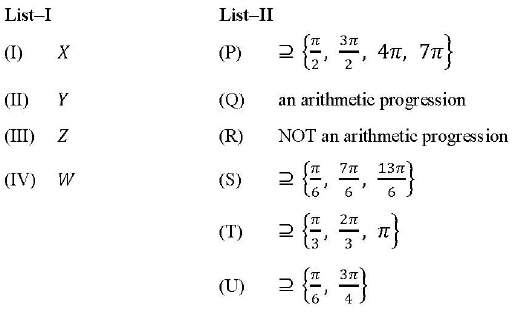
15. Which of the following is the only CORRECT combination?
(A) (I), (P), (R)
(B) (II), (Q), (T)
(C) (I), (Q), (U)
(D) (II), (R), (S)
16. Which of the following is the only CORRECT combination?
(A) (III), (R), (U)
(B) (IV), (P), (R), (S)
(C) (III), (P), (Q), (U)
(D) (IV), (Q), (T)
Answer Q.17 and Q.18 by appropriately matching the lists based on the information given in the paragraph.
Let the circles C1 : x2 + y2 = 9 and C2 : (x – 3)2 + (y – 4)2 = 16, intersect at the points X and Y. Suppose that another circle C3 : (x – h)2 + (y – k)2 = r2 satisfies the following conditions :
(i) centre of C3 is collinear with the centres of C1 and C2,
(ii) C1 and C2 both lie inside C3, and
(iii)C3 touches C1 at M and C2 at N.
Let the line through X and Y intersect C3 at Z and W, and let a common tangent of C1 and C3 be a tangent to the parabola x2 = 8αy.
There are some expressions given in the List-I whose values are given in List-II below :
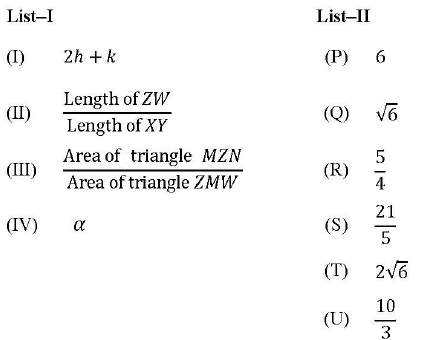
17. Which of the following is the only CORRECT combination?
(A) (I), (S)
(B) (I), (U)
(C) (II), (Q)
(D) (II), (T)
18. Which of the following is the only INCORRECT combination?
(A) (I), (P)
(B) (IV), (U)
(C) (III), (R)
(D) (IV), (S)
Latest Govt Job & Exam Updates: